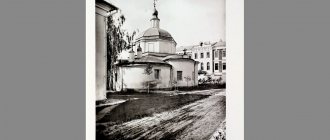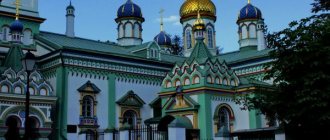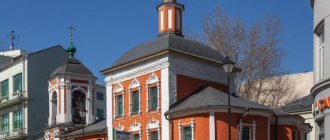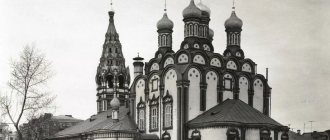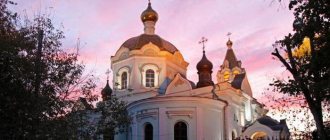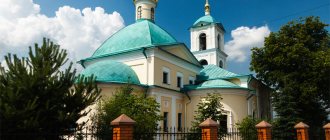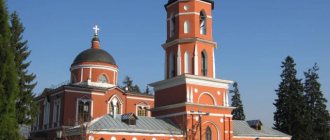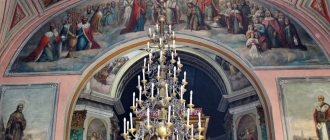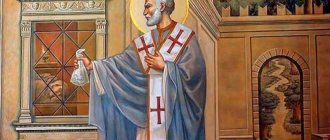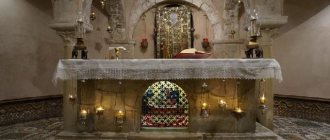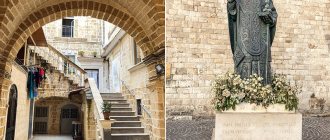This wonderful shrine, which became a haven for the most revered Orthodox Church icon of the Most Holy Theotokos “Vladimir”, is located in the central part of Zamoskvorechye. The Church of St. Nicholas is a real museum, because behind its walls are hidden the best exhibits of modern and ancient icon painting. The house church has become the most important part of the Tretyakov Gallery, which is visited daily by hundreds of people.
In 1697, 2 merchants built a single-limit church in honor of St. Nicholas
In 1697, 2 merchants, son and father, decided to build a single-department church in honor of St. Nicholas the Wonderworker. In 1770, many sources indicate him as Soshestvensky.
In 1770, the Intercession Limit was built in the refectory church of St. Nicholas. The widow of the merchant of the first guild, Demidov, helped with this. She allocated the necessary funds for the construction of the chapel.
In 1812, during Napoleon's attack, miraculously the Church of St. Nicholas remained untouched. Photo: hramvtolmachah.ru
In 1812, as many know, there was a war. During Napoleon's invasion, a real miracle was shown to the temple. During the fire, all the surrounding buildings were destroyed by fire, but the Church of St. Nicholas miraculously remained undamaged.
It was there that local residents took refuge from smoke and fire. Then the property of the temple, which was securely hidden under the floor, also survived completely. But while defending the temple, priest John Andreev fell as a martyr.
1812
this year, in Moscow, burned by Napoleon, the St. Nicholas Church miraculously remained intact and sheltered residents from the fire
Napoleon's captors tortured him to find out where he hid the church treasures, but after the victory he died from his injuries. According to another version, it is stated that he was killed on the porch and buried in the fence of the temple.
Many still cannot understand how such a miracle could happen. But, unfortunately, it was still desecrated by the French.
History of the temple
The first stone church of St. Nicholas in Tolmachi, inside of which there were two altars, was designed and erected in 1697. The main altar was consecrated in honor of the Descent of the Holy Spirit, and the second altar, Nikolsky, was decided to be moved to the refectory located at the temple.
In 1770, the widow of a wealthy merchant Demidov allocated a large amount of funds for the construction of a new chapel inside this refectory.
At the end of 1812, when the decision was made to set Moscow on fire, the clergy house and almshouse located next to the church burned down, but the building of the St. Nicholas Church itself remained untouched by the fire. Even before the fire, all the valuables stored in it were hidden, and only the antimins, which they had desecrated, could not be hidden from the eyes of the French. The temple remained closed until February 1813, and when it was reopened, both aisles were rededicated.
Around 1834, the famous architect F.M. Shestakov, with the blessing of Metropolitan Philaret, was able to rebuild the refectory, in which two symmetrical aisles were made, and then designed a new bell tower, in which as many as three tiers were planned. They were erected shortly after design. The interior decoration of the bell tower was made of artificial marble. Several new bells were also cast for it, one of them was a festive one. Twenty years later, the main altar was rebuilt at the expense of Daniil Tretyakov’s daughter Alexandra Danilovna and her sons.
In 1922, more than 150 kilograms of gold and silver items were confiscated from the temple, and seven years later, in 1929, the temple was closed. It resumed its work only in 1993. All these years it was used as an office space for the Tretyakov Gallery, and everything inside the temple was partitioned off. Only the slightly altered first floor reminded us that religious services were once held here. Almost three years after its opening, it was consecrated by His Holiness Patriarch Alexy II of Moscow.
By mid-1997, one of the largest reconstructions of the temple was completed. During the event, the bell tower was re-erected. In addition, several iconostases and all the wall paintings were recreated.
After Napoleon's invasion there were no services in St. Nicholas Church
About 5 months after the invasion of Napoleon's troops, there were no divine liturgies in the St. Nicholas Church. It was completely empty, and had lost its parish. At that time, not a single house survived in the area.
In 1813, Nikolai Yakovlev became the priest of the Church of St. Nicholas in Tolmachi.
A little later, the Nikolsky and Pokrovsky limits were illuminated. But since there were no people, the temple was assigned to the Church of St. Gregory of Neocaesarea. At that time, the Tolmachevo people were very upset; they submitted a petition to the Reverend Augustine asking him to return the temple.
Church of St. Gregory of Neocaesarea in Polyanka at present. It was to this temple that the Church of St. Nicholas in Tolmachi was assigned. Photo: pastvu.com
Local residents were even ready to pay any amount for the maintenance of the clergy, if only the parish church received its primitive essence.
This case was set in motion, and later it turned out that the Church of St. Gregory had even fewer parishioners than the St. Nicholas Church, which was perfectly preserved after the war, had at that time.
On February 5, 1814, a decree was issued to restore the independence of some churches.
The Church of St. Nicholas was also included here. This is how the parishioners, albeit in small numbers, defended their temple in Tolmachi.
Gradually the temple began to come to life, and the area around it began to develop. Merchants, industrialists and wealthy parishioners built here. At that time, stone houses began to be built.
As of the 19th century, all houses were completely rebuilt on Tolmachevsky Lane. It is also surprising that some houses have survived to this day.
St. Nicholas Church in Tolmachi. Part II
Continuation. PART I is here
In 1851, P.M. became a parishioner of St. Nicholas Church in Tolmachi. Tretyakov, whose family bought an estate on Lavrushinsky Lane. The Tretyakovs were very religious people. They not only went to church, but also became the main donors. Until his death, Pavel Mikhailovich lived in his house and went to St. Nicholas Church. He made a special gate through which one could enter the church directly from the estate. The Tretyakovs were connected with Nicholas the Wonderworker: Pavel Mikhailovich’s grandfather once lived in the parish of the Church of St. Nicholas in Golutvin. The family had a tradition of getting together on St. Nicholas Day and remembering with kind words all the deceased relatives.
In the 1860s, it was again necessary to repair artificial marble, update paintings, repair facades, and change floors in the main church. The Tretyakov family invariably helped their temple in everything. The elder of the Smolensk Zosimova Hermitage, Venerable Alexy, said wonderful words about Pavel Mikhailovich: “In my mind, when I remember him, there arises the image of a man who served as an example of a sober, focused, abstinent life, full of good energy and labors, and, most importantly, the image of a man who combined possession external wealth - material - with spiritual poverty. This was evident in his humble prayer.”
In the second half of the 19th century, deacon Fyodor Alekseevich Solovyov, the future elder Alexy Zosimovsky, served in the Church of St. Nicholas in Tolmachi. He was distinguished by modesty, responsiveness, respectful attitude towards elders, reverent service and a magnificent velvet voice. The parishioners loved their deacon very much. In 1872, his beloved wife died. This was a terrible blow for Fyodor’s father; sometimes he locked himself in his room and cried inconsolably. The rector of the church, Father Vasily, came to the rescue. He loaded Fyodor Alekseevich with work in the magazine “Soulful Reading,” published at the temple.
The deacon wrote a short history of the church and other literary works. And work really saved him from grief. Father Fyodor always came to the church first and was the last to leave, not forgetting to pray in front of each icon and make sure everything was in order. He used to take off his hat when greeting his acquaintances. But since he knew almost the entire parish personally, he almost always walked with his head uncovered. Church historiographer O.S. Chetverukhina noted: “One old woman, who was then still a ten-year-old girl, later recalled that she especially loved meeting him, because Father Deacon “greeted very well.”
After early mass, Fyodor Alekseevich usually gave out alms, which were especially generous on the day he received his salary. They even gave him money in parts so that he did not give it all away at once. The deacon willingly helped all the poor in the area, often inviting them to his home for dinner. One day, having no money with him, he, without hesitation, gave his cassock to a beggar shivering from the cold. In 1895, Father Fedor was ordained presbyter of the Assumption Cathedral. Three years later he was tonsured a hieromonk with the name Alexy. Now he is known to everyone as Reverend Alexy Zosimovsky - one of the most glorious and revered elders of the twentieth century.
The last renovation of the temple took place in 1910. After the 1917 revolution, people stopped going to church. The young priest Ilya Nikolaevich Chetverukhin, a friend of Father P.A. Florensky and the spiritual child of Elder Alexy, made every effort to preserve the Church of St. Nicholas in Tolmachi. In 1922, more than nine pounds of gold and silver items were confiscated from the temple. Father Ilya was an excellent draftsman and a lover of painting, and, since he needed to earn a living, he got a job as a research assistant at the Tretyakov Gallery. Soon he was asked to choose between the Tretyakov Gallery and the temple. Of course, he chose to serve God.
Hard times have begun. This is how O.S. describes the life of Ilya’s father in those years. Chetverukhin: “Father Ilya performed services in a church sparkling with frost, miraculously there was wine for communion and flour for prosphora, there was not enough for the most urgent needs: the children and even the mother had no shoes, clothes were altered from all sorts of old things. The family went to bed not knowing what they would eat tomorrow, according to the principle “when there is day, there is food.” Despite all the difficulties, the active priest diligently continued his work. The few parishioners loved the sincere sermons of Father Ilya, dedicated to the love of God and all neighbors.
Gradually, a community of deeply religious parishioners who knew the Holy Scriptures developed around him, and the Church of St. Nicholas in Tolmachi began to be called the “Tolmachev Academy.” On Easter 1929 the church was closed. Employees of the Tretyakov Gallery demanded that the temple building be given to them for storage. The priest and parishioners did everything to defend the temple, but their efforts were in vain. For the second time in history, the parish was assigned to the Church of St. Gregory of Neocaesarea in Polyanka. In 1930, Father Ilya was arrested for “counter-revolutionary agitation and preparation for an uprising” and two years later died in a fire in a camp club in the village of Krasnaya Vishera.
In 1931, reconstruction of the church began as a storage facility for the Tretyakov Gallery. The chapters were removed, the upper tiers of the bell tower were dismantled, and the interior space was divided into floors. The temple lost its iconostasis and 19th-century fence. It is difficult to say whether St. Nicholas Church in Tolmachi was lucky that it was transferred to the Tretyakov Gallery. At least the building wasn't completely destroyed. When the reconstruction of the gallery began, it was planned to set up a concert hall in St. Nicholas Church. By 1990, the domes and bell tower were restored. Fortunately, no concerts were held in the temple. In 1993, they made an unexpected decision to make the church a house at the gallery.
Services in the church resumed on September 8, 1996, on the feast of the Vladimir Icon of the Mother of God. Patriarch Alexy II consecrated the main altar of the Descent of the Holy Spirit. It was then that a significant event occurred: for the first time, the icon of the Vladimir Mother of God, the guardian and intercessor of the Russian land, was brought to the Church of St. Nicholas in Tolmachi. The complete restoration of the temple was completed in 1997. The lost painting was restored, including the famous scene of the expulsion of merchants from the temple, which so amazed the parishioners. Two years later, the icon of the Vladimir Mother of God found its permanent place of refuge - the Church of St. Nicholas in Tolmachi.
Today everyone can pray and worship the shrine. It is stored in a bulletproof icon case specially manufactured at the Russian Ministry of Atomic Energy plant. According to legend, this icon was painted by the Evangelist Luke during the life of the Mother of God on a board from the table at which Jesus Christ ate with Her and Joseph. In fact, this is a Byzantine icon of the first half of the 12th century, brought by Prince Andrei Bogolyubsky from Constantinople. But does the origin of this image and the date of writing matter? The main thing is that she saved our country many times from troubles and misfortunes, that people turned to her for help in the most difficult moments of history, and she always helped.
In 2000, at the council of bishops in the Cathedral of Christ the Savior, Elder Alexy was canonized, and two years later, Father Ilya was canonized with the rank of hieromartyr. They became the heavenly patrons of the Church of St. Nicholas in Tolmachi, and their images were placed on the right wall. Surprisingly, Father Ilya is depicted wearing glasses, although according to the canons saints should not have glasses. Festive services in the temple are held with the participation of the famous chamber choir of the Tretyakov Gallery. The founder and director of the choir is Alexey Puzakov, the famous regent of the Church of the Icon of the Mother of God “Joy of All Who Sorrow.”
St. Nicholas Church cannot be seen from afar: it is blocked by the new Tretyakov buildings built in the 1980s. But now the gates of the Engineering Building are often open, and everyone has the opportunity to walk around the temple from all sides. Despite all the destruction, St. Nicholas Church has been well preserved. The temple is a rare architectural monument that combines elements from different eras. But another sign of its exclusivity is its special status - a temple-museum. A significant part of its decoration, as well as altar crosses and liturgical utensils, are exhibits from the collection of the Tretyakov Gallery. After the service, the church turns into an exhibition hall.
In 1834, a new bell tower was built near the temple in Tolmachi
In 1832, the bell tower of the church in Tolmachi became severely askew, and the refectory suffered small but significant cracks.
In the same year, with the blessing of St. Philaret, Metropolitan of Moscow and All Rus', at the expense of parishioners, a new 3-tier bell tower and a refectory with two symmetrical boundaries were laid and illuminated. This happened on November 25, 1834.
A new dome was cast on the 2nd tier of the bell tower, but the rest of the bells were left the same.
Interior decoration of the Church of St. Nicholas today. Photo: mukckd.ru
It is worth paying attention to the interior decoration of the temple. The bell tower was made of artificial marble. By 1845, even most of it had been lost, and so the decoration was later replaced by painting.
The rector of the temple, Nikolai Romanov, was responsible for the splendor and all restoration work. In 1849, it was he who was appointed spiritual clergyman of the Zamoskvoretsky forty.
1849
this year Nikolai Romanov was appointed spiritual priest of the Zamoskvoretsky Forty
Nowadays
Nowadays, the temple has remained virtually unchanged: externally it is a 17th-century quadrangle with a 19th-century refectory with two side chapels.
The Church of St. Nicholas in Tolmachi has been a landmark of the Russian capital for a long time and has the status of a temple at the Tretyakov Gallery. Therefore, all conditions suitable for storing shrines, which are the property of the entire Russian people, were specially created in it.
For decades, in celebration of the Holy Trinity, the icon of the great Russian icon painter Andrei Rublev “Trinity” has been brought here, which was specially taken out from the Tretyakov Gallery for this purpose.
The Tretyakov family played a major role in the life of St. Nicholas Church
In 1851, the Tretyakov family came to Lavrushinsky Lane. And in the early 60s, Countess Maria Fedorovna Sologub came to the Demidovs’ estate. It was thanks to the people who came here that St. Nicholas Church received the necessary help and support.
The Tretyakov family. Photo: hramvtolmachah.ru
The central part of the altar was rebuilt at Tretyakov’s expense. A new five-tier gilded iconostasis was also made. It is worth noting that the composition of many paintings has survived even to this day.
Many famous people began to come to the temple in Tolmachi. Tretyakov himself attended festive liturgies, and was very upset if one of the employees of private galleries was absent from the divine liturgy.
It is also worth noting that Maria Fedorovna Sologub, who bought the Demidovs’ estate in the early 60s, also made considerable efforts.
At this time, many relatives and friends came to visit her, who also contributed to the development of Christian philosophy, which was based on deep roots in the traditions of the church.
The magazine Soulful Reading, which was organized by confessors from St. Nicholas Church in Tolmachi. Photo: hramvtolmachah.ru
In 1860, the rector of the church, Father Vasily, together with priest Alexei and Vasily Lebedev, founded the magazine Soulful Reading. Deacon Fyodor Solovyov, who in the future became a famous elder, also helped in this activity.
Since he was widowed at an early age, he directed all his spiritual forces to the development of Christian enlightenment. In 1770, he even published his book, where he tells the history of the temple.
In 1929, the temple in Tolmachi was closed
The 20th century was one of the turning points for many temples and churches. In 1922, 157 kg of gold and silver items were confiscated from the temple, after which the church was closed in 1929.
After closing, the temple stood empty and disfigured for a very long time. The Tretyakov Gallery was located in its building. Everything inside was redone and divided into several floors, which served as the museum's depository.
1929
this year the church was closed, the Tretyakov Gallery was located in its premises
Only the 1st floor was a little reminiscent of the very temple where people came to pray for the Divine Liturgy.
The Tretyakov Gallery first began a major restoration to restore the temple building. They wanted to open a concert hall in it. In 1990, the heads of the church bell tower were installed.
In 1990, priest Nikolai Sokolov received a decree for the Church of St. Nicholas in Tolmachi, which was given the status of a house church at the Tretyakov Gallery. It was from that moment that St. Nicholas Church became the first church-museum in Russia.
Currently, in the church in Tolmachi there is a miraculous icon of the Vladimir Mother of God
Before the official restoration, the divine liturgy was celebrated in the main chapel. All the icons that are in the temple are surviving images from various Moscow and other Russian churches.
There are very few native temple icons - this is the icon of St. Nicholas and the heavenly row of icons. Over time, the painting of the temple was also restored. The first service took place on the day of “Winter St. Nicholas” on December 19.
Church of St. Nicholas the Wonderworker in Tolmachi: what's nearby?
The Church of St. Nicholas the Wonderworker in Tolmachi is located in relative proximity to the following attractions in the region
Due to the uneven distribution of world attractions, the relative proximity of objects should be taken into account.
Tretyakov Gallery ~ 0.1 km. Church of the Icon of the Mother of God “Joy of All Who Sorrow” on Bolshaya Ordynka ~ 0.3 km
Church of the Icon of the Mother of God “Joy of All Who Sorrow” on Bolshaya Ordynka ~ 0.3 km
Church of the Resurrection of Christ in Kadashi ~ 0.3 km
Monument to Anna Akhmatova ~ 0.4 km
Bolshaya Ordynka Street ~ 0.4 km
Church of St. Nicholas the Wonderworker in Pyzhi ~ 0.4 km
Church of St. Gregory of Neocaesarea in Derbitsy ~ 0.4 km
Luzhkov Bridge ~ 0.4 km
The consecration of the main altar was performed by Patriarch Alexy II
Patriarch of Moscow and All Rus' Alexy II consecrated the main altar of the restored temple. This lighting was associated with a great holiday, because it was the Vladimir icon that was in the gallery. It was then that she was first brought to St. Nicholas Church for worship.
In the photo, Patriarch of Moscow and All Rus' Alexy II is in the church in Tolmachi. He stands with the priest in front of the icon of the Mother of God of Vladimir. Photo: magiya.guru
The complete restoration of the temple was carried out with funds from the Tretyakov Gallery and parishioners. The entire restoration was completed only in 1997. Then an icon case was made for the Vladimir icon with the required temperature maintained inside.
This experiment turned out to be successful, and the museum workers considered it possible to transfer Andrei Rublev’s Trinity icon to the Church of St. Nicholas the Wonderworker at least once a year on the feast of the Holy Trinity.
Trinity Icon: 2 prayers
Thus, the Church of St. Nicholas the Wonderworker in Tolmachi was able to regain its splendor and acquired shrines, without which many parishioners cannot imagine their lives.
Story
The first mention of the wooden “Church of the Great Wonderworker St. Nicholas, and in the limit of Ivan the Baptist, which is beyond the Moscow River in Tolmachi” was found in the Parish Book of the Patriarchal Order for 1625.
In 1697, a stone church was erected; its author was the “guest” Longin Dobrynin, a parishioner of the Church of the Resurrection in Kadashi. The main altar of the temple was consecrated in honor of the Descent of the Holy Spirit, and Nikolsky was moved to the refectory.
From 1697 to 1770, the church was called “Soshestvenskaya” in business papers and books, and then began to be registered again as “Nikolaevskaya”.
In 1770, the Pokrovsky chapel was built in the refectory at the expense of the widow of the merchant of the first guild I. M. Demidov.
In 1834, the refectory was rebuilt according to the design of the architect Fyodor Shestakov at the request of parishioners and “in accordance with the thoughts of Metropolitan Philaret” and a new bell tower was erected.
Temple in 1883. Photo from Nikolai Naydenov's album
In 1856, the quadrangle was updated and the main altar was rebuilt. Funds for the renovation of the temple were also donated by Alexandra Tretyakova and her sons.
After 1894, the temple received a library of ancient manuscripts of eastern ascetics, collected by Theophan the Recluse and purchased after his death from his heirs by the Moscow merchant Losev. In 1889, Dimitry Kositsyn was appointed priest to the temple. In 1902, Mikhail Fiveysky became the rector of the temple.
In June 1919, parishioners elected Ilya Chetverukhin as rector of the temple. In 1929 the temple was closed.
In 1993, the temple was transferred to the Russian Orthodox Church. According to Archpriest Nikolai Sokolov, “the building belonged to the museum; it housed various services of the Tretyakov Gallery. When the new depository was built, everyone left from here. For three years the temple stood abandoned. There is no need to explain what “windows and doors are open” meant in the nineties. Everything that was possible: bricks, marble, flooring - everything was removed and taken away.”
On September 8, 1996, the main altar of the temple was consecrated by Patriarch of Moscow and All Rus' Alexy II.
In 1997, reconstruction was completed, the bell tower was re-erected and the five-domed quadrangle was restored, three iconostases and wall icon cases were recreated, and wall paintings were completely restored.
Synodik of the temple
Pavel Tretyakov is a parishioner of the temple, the founder of an art gallery.
The following were canonized by the Russian Orthodox Church in the 21st century:
- Rev. Alexy Zosimovsky (1846-1928) - Fyodor Solovyov, who served as a deacon in the church for 28 years;
- Martyr Nikolai Rein (1892-1937) - parishioner of the temple;
- Hieromartyr Ilya Chetverukhin (1886-1932) - the last rector of the temple before its closure in 1929.
Currently there is an official website of the Church of St. Nicholas in Tolmachi
Currently there is an official website of the Church of St. Nicholas in Tolmachi. On the website you can find out news, the history of the temple, and also find out the schedule of services of the Church of St. Nicholas in Tolmachi. Anyone who wants to visit this temple can come to the address: Moscow, Maly Tolmachevsky Lane, building 9.
Church of St. Nicholas the Wonderworker in Tolmachi. Photo: uspeniya.cerkov.ru
The entrance to the museum of the Church of St. Nicholas in Tolmachi is through the building of the Tretyakov Gallery, which is located to the left of the temple building.
Opening hours: Tue - Sun 12:00 -16:00.
Phone: +7 495 957‑07-81.
By leaving a comment, you accept the user agreement
Schedule of services
Church of St. Nicholas the Wonderworker in Pokrovsky
Entrance to the temple is through the door in the main building of the Tretyakov Gallery, located just to the left of the bell tower. Before going upstairs, you must leave your outerwear in the wardrobe.
For visitors to the State Gallery, the Church of St. Nicholas in Tolmachi is open any day except Monday, from 12-00 to 16-00. You can go inside through the main entrance to the Tretyakov Gallery, which is clearly visible and therefore cannot be confused with any other.
On weekends, as well as during Great Holidays, the Divine Liturgy begins at 9-00, and before the All-Night Vigil - at 17-00.
On Fridays at 5 p.m., an akathist to the Vladimir Icon of the Mother of God is read (but not during Lent).
On the days of the icons of the Mother of God, Matins is held at 8-00, and after it the Divine Liturgy.
There is also a church library at the temple. Library opening hours:
- Saturday - from 15-30 to 17-00
- Sunday - after the end of the Divine Liturgy and until 14-00.
